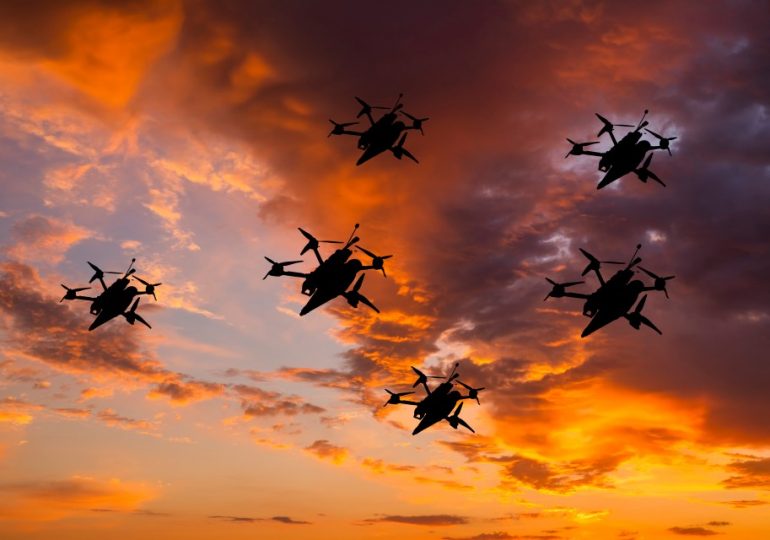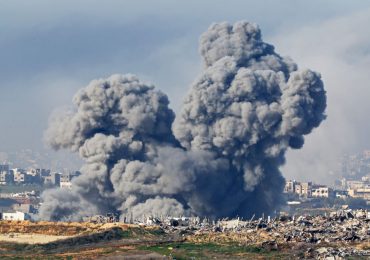AS Ukraine runs desperately short on ammunition, small killing machines buzz across the battlefield, hunting down the enemy and decimating its tanks.
FPV drones are “our sword, our strike force” against Russia’s advance, special ops warrior “Arsenal”, the commander of Kyiv’s attack drone operations, told The Sun.
GettyA swarm of FPV kamikaze drones flies above the battlefield – hunting down enemy targets and destroying heavy Russian infrastructure[/caption]
POV footage as a FPV drone – which Ukraine now relies on to hold off Russia’s advance – goes in for the kill
The suicide UAV detonates as it smahses into the £1million Russian T-72 tank and tears it apart
ReutersUkraine promised to build a million of its own drones in 2024[/caption]
Ukraine has become increasingly reliant on first-person-view (FPV) drones — nimble target-seeking, kamikaze unmanned aerial vehicles (UAVs).
The cheap, explosive, flying machines have become one of Kyiv’s biggest success stories on the battlefield.
“This is undeniable,” said Arsenal, who goes by his call sign for security reasons.
The senior officer is head of FPV drones at the State Transport Special Service, a specialised military unit attached to Ukraine’s Ministry of Defence.
With the 600-mile front frozen in hellish trench warfare, Arsenal said the conflict is moving into a “technological war” and developing attack drones is key to this.
The quadcopters cost around £300, are largely made from off-the-shelf pieces of kit and are now often assembled into precision weapons by civilians in their homes.
The only thing preventing Russia’s breakthrough on all fronts is FPV drones
Lt. Cl. Pavlo Kurylenko
Some are fitted with grenades or homebuilt bombs, others are used for reconnaissance missions to identify enemy positions and guide artillery fire.
“I used to shoot such ‘cinematic’ videos with the help of FPV-drones before the war,” Ukrainian filmmaker Anton Ptushkin posted on X last November.
“Now we use FPV to defend our land.”
The attack UAVs have come to define the conflict, helped by constant streams of footage filmed onboard as they tail troops, blast Russian positions or smash into tanks with ruthless precision.
Since early 2023, Ukraine truly began to appreciate the potential of FPVs and Russia was forced to catch up.
Arsenal revealed that the killer drones now successfully blitz Putin’s targets in three out of five operations.
“FPV drones are extremely important in this war. Absolutely every drone, even the ones that fall under the influence of Russian electronic jamming, save lives.
“If Mavic (surveillance) drones are our eyes – for the adjustment of artillery fire, withdrawal of groups to positions, reconnaissance – then FPV drones are our sword, our strike force.”
Over two thirds of Russian tanks destroyed by Ukraine in recent months have been taken out using FPV drones, a Nato official told Foreign Policy.
Their long-range capabilities also save countless lives as the drone operator can be stationed away from the frontline.
“They make it safe for the pilots,” Arsenal said. “If earlier the grenade launcher had to be in the direct line of sight of the tank in order to hit it, risking his life, now this ‘shot’ with the same RPG projectile is carried out from a distance of 3-15km.”
When asked about this most successful design characteristic, Arsenal proudly said: “There are many of them,” before adding, “But, unfortunately, I can’t comment on this for security reasons.”
They’re also being constantly adapted and upgraded as Ukraine’s military learns from each new battle.
Last week, Kyiv announced it was building a new fleet of so-called “unstoppable” AI-powered FPVs designed to hunt down and strike targets on their own, while being less susceptible to Russian interception or jamming.
ReutersThe modified quadcopter is launched into the sky[/caption]
ReutersTheir highly-skilled operators can be stationed safely away from the frontline[/caption]
Twitter/@DefenceUAn FPV – guided by the ‘Spartan Brigade’ – heading straight for another T-72 Russian tank worth before exploding on impact[/caption]
Twitter/@DefenceUThe aerial killing machines blitz three out of five targets, senior commander Arsenal revealed[/caption]
Seconds later, Putin’s expensive tank exploded into flames – sparking a huge fireball that could be seen for miles
A NUMBERS GAME
While Ukraine “is certainly not far behind Russia” in terms of drone warfare, Arsenal said, “but we lag behind in the number of drones and in their intensity”.
But Ukraine’s MoD has a ruthless determination to change that.
When Ukraine’s new commander in chief, General Syrskyi, was appointed in February he warned that the only way to defeat Russia would be to achieve a technological edge.
Setting a new battle agenda, he argued that mastering drone warfare and developing more sophisticated weapons would allow Kyiv “to seize the strategic initiative” from a better equipped and larger foe.
In 2023, Ukraine’s goal was to procure 200,000 drones. For 2024, Zelensky vowed they would build a million themselves.
Between January and February this year, officials revealed FPV production already totalled 200,000.
Ukraine is also counting on key allies to send them more expensive, high-tech drones, but deliveries are not anywhere near the sufficient scale needed.
In March, the UK announced they will supply Kyiv with 10,000 drones – 1,000 of which are FPVs – throughout 2024.
Despite targets and promises, deliveries are slow. But does Ukraine have enough homegrown FPVs to make up for it?
One of Kyiv’s top military commanders said the lack of Western-supplied weaponry had gone from “bad” to “horrible” as frontline units were increasingly having to source their own donated UAVs.
Lt. Cl. Pavlo Kurylenko told The Telegraph: “The only thing preventing Russia’s breakthrough on all fronts is FPV drones, 90 per cent of which are being provided by volunteers or military divisions themselves.”
A HOMEGROWN, CROWDSOURCED FLEET
Far behind enemy lines, an army of volunteers have been quietly assembling drones in their kitchens, sheds and bedrooms.
“Do you want to build an FPV drone with your own hands that will burn a Russian tank? Then this opportunity is for you!” an advert for the “People’s FPV” program reads.
That particular programme has roughly 10,000 volunteers, while other volunteer drone companies manage to produce thousands of drones each month.
For the less tech-savvy Ukrainians, they are busy sending whatever money they can into crowdsourced projects.
Ukrainian fundraising platform, United 24, a project launched by Zelensky, has particularly spearheaded these efforts.
It helped to raise £4.7million in just three days for a new fleet of upgraded 5,000 FPV drones as part of “Operation Unity”.
The money poured in from 303,659 different people and over a hundred businesses.
Arsenal confirmed that United24’s crowdsourced drones were already working wonders on the frontline.
AlamyUkraine is desperate for longer-range drones[/caption]
ReutersA specialist soldier is seen assembling a drone close to the frontline – but civilians are now helping to construct the UAVs from home[/caption]
Kyiv is running painfully low on ammo and artillery – leaving them vulnerable to deadly Russian attacks
ReutersFPV drones have had to make up for the lack of munitions[/caption]
NOT ENOUGH
Valerii Riabykh, former consultant to Ukraine’s military and CEO of Defence Express, said that while FPV drones are “essential to the battlefield”, ground cannot be taken without artillery.
As a £50billion US military aid package is blocked in Congress, Ukraine lost hard-fought positions back to the Russians.
Kyiv cannot produce the ammunition and artillery systems it needs and its allies can’t or haven’t sent enough to properly supply frontline troops.
So FPV drones, used en masse, were forced to take centre stage to slow Russia’s advance.
Riabykh told The Sun: “We are estimating that 50 per cent of targets on the battlefield are hit by FPV drones,” adding that 30 per cent of targets are tanks and other heavy equipment.
Despite their successes, he said they “cannot replace artillery, they have different missions on the battlefield”.
This issue was the focus of a new report by Dr Jack Watling, senior research fellow for land warfare at RUSI, who argued that Ukraine’s intensifying need for FPV is not sustainable in the long-term.
“FPVs don’t replace artillery, they only complement forces,” he said.
“They have a unique contribution to make but are susceptible to electronic warfare and are hard to synchronise with offensive actions.”
A drone operator within Ukraine’s 36th Marine Brigade, known as “Kriegsforscher,” backed this up with his experience at the front.
Writing on X, he said: “Unfortunately, we use so much FPV drones because of lack of ammo for mortars, ATGMs, artillery and even anti-tank mines.
“They are cheap and very effective, first of all, against enemy logistics. That’s out of the question and they are really needed.”
However, he argued they are “not the key”.
“The key,” he said, is Ukraine having enough artillery shells, more armoured fighting vehicles and a well-trained infantry to fight back against the Russian advance.
A Ukrainian drone operator guiding the suicide drones to their targets
ReutersSmaller FPV drones loaded up with explosives[/caption]
A soldier of a Ukrainian reconnaissance drone unit shows a photograph of a previous successful strike on Russian forces at a position in Donbas
ReutersA troop in his workshop fixing FPV drones at night[/caption]
FPVs cannot replace artillery, analysts say, but Ukraine has been forced to cover for its losses with the UAVs while Western weapon deliveries stall
Leave a comment








